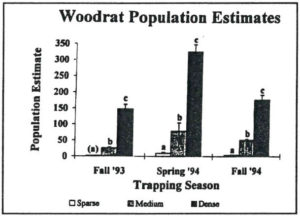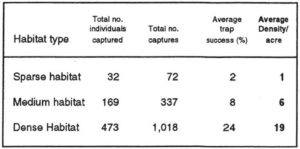Oaks ‘n’ Folks – Volume 10, Issue 1 – April, 1995
In outward appearance, the dusky-footed woodrat is almost identical to the Old World rats. Similarity, however, stops there. Taxonomically the two species are unrelated and very different ecologically. Unlike the Old World rats, the dusky-footed woodrat is native to North America. From Washington state southward to California, they live in dense vegetation, preferably among oak trees (Quercus spp.). Dusky-footed woodrats have the unusual habit of collecting and accumulating woody debrisóand most any available small objectóinto piles or nests which serve as living quarters, hence, the name packrat.
An important inhabitant of California oak woodland, the dusky-footed woodrat is a significant food for small- to medium-sized predators. It comprises most of the diet of the California spotted owl (Strix occidentalis occidentalis), for example, in the Sierra foothill oak woodland and the isolated mountain ranges of southern California. Researchers at UC Berkeley recently found that in northern California, dusky-footed woodrats serve as the primary wildlife host for the tick vector of the Lyme disease spirochete. The Monterey dusky-footed woodrat (N. f. luciana), a subspecies which occurs in coastal central California, is also considered a California Species of Special Concern.
Yet, information is largely lacking on dusky-footed woodrat demographics and habitat associations in California oak woodland. I therefore decided to examine first-year data on woodrat abundance and habitat relationships from a longer-term study of terrestrial vertebrates at Camp Roberts, in coastal central California.
Methods
Nine square 20-acre study plots were established in summer 1993. Within each, a 17-by-17-sampling grid was laid out. Based primarily on the amount of brush cover and dead-and-down, I subjectively categorized all the plots as sparse, medium, or dense. I measured cover of tree canopy, brush foliage, and dead-and-down material on tenth-acre subplots on one sparse, one medium, and one dense plot.
Small mammals were trapped on the nine study plots in fall 1993 and spring and fall 1994 by placing a single live trap at each of the 289 grid intersections per plot. Traps were baited and checked for five successive days. Total trapping effort on the nine study plots was 39,015 trap nights.
The vegetation and capture data were summarized with means and standard errors. Differences between means were tested with ANOVA.
Results
Significantly (P<0.05) more oak tree cover occurred on the medium (67%) and dense (56%) plots than on the sparse (45%) plot. Percent brush cover increased by a magnitude of about three times between the sparse (3%), medium (10%), and dense (31%) plots; significantly more brush occurred on the dense plot. Similarly, the dense plot was characterized by more dead-and-down (3%) than the sparse or medium plots (2%), although the difference was not significant.

There was a clear positive relationship between vegetative cover and woodrat numbers. During all three trapping periods, woodrat population estimates increased dramatically (P<0.05) across the sparse, medium, and dense plots where vegetation was measured (Fig. 1). The highest population estimates were calculated for the spring trapping period. During spring, the woodrat population was 10 on the sparse plot, 79 on the medium plot, and 326 on the dense plot.
Summary demographic data for all nine study plots is presented in Table 1. Capture of woodrats per 1,445 trap nights ranged from zero on a plot with almost no brush or dead-and-down cover to 540 captures of 226 individuals on a plot with much understory cover. Average woodrat density of the pooled estimates for the sparse, medium, and dense study plots was 1, 6, and 19 animals/acre, respectively. On the eight plots where woodrats were captured, woodrat density ranged between 1 animal/acre on a sparse plot to 27 animals/acre on a plot with dense understory.
Conclusions and Management Implications

Results from this study show clearly that vegetative structure affects dusky-footed woodrat abundance, with brush cover apparently contributing most to high wood-rat numbers. The positive relationship found here between vegetative structure and dusky-footed woodrat abundance generally supports the findings of other studies conducted in oak woodland and in mixed conifer forests. I was surprised, however, to find that the upland oak woodland at Camp Roberts has so many woodrats. Woodrats are as abundant at Camp Roberts as they are in mixed conifer forests of the Pacific Northwest and the Sierra Nevada. Dusky-footed woodrats are undoubtedly an important contributor to the richness and abundance of the wildlife in California oak woodland.
The results presented here are preliminary; however, the woodrat population estimates are probably good approximations of the high populations of dusky-footed woodrats than can occur in oak woodland with well developed vegetative structure. It follows that management activities in oak woodland that result in more live trees, brushy cover, and dead-and-down material will result in an increase in the abundance of woodratsóand, associated wildlife.
prepared and edited by John M. Harper, Richard B. Standiford, and John W. LeBlanc
